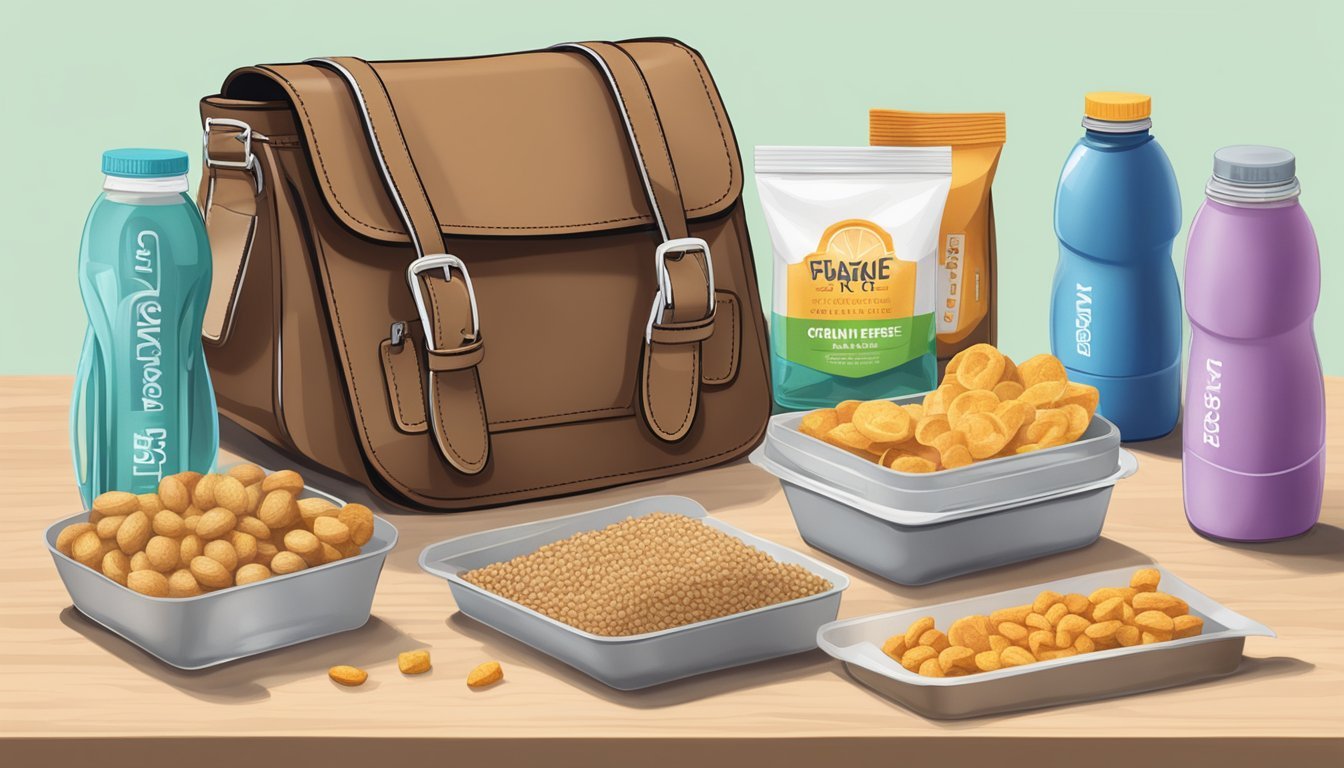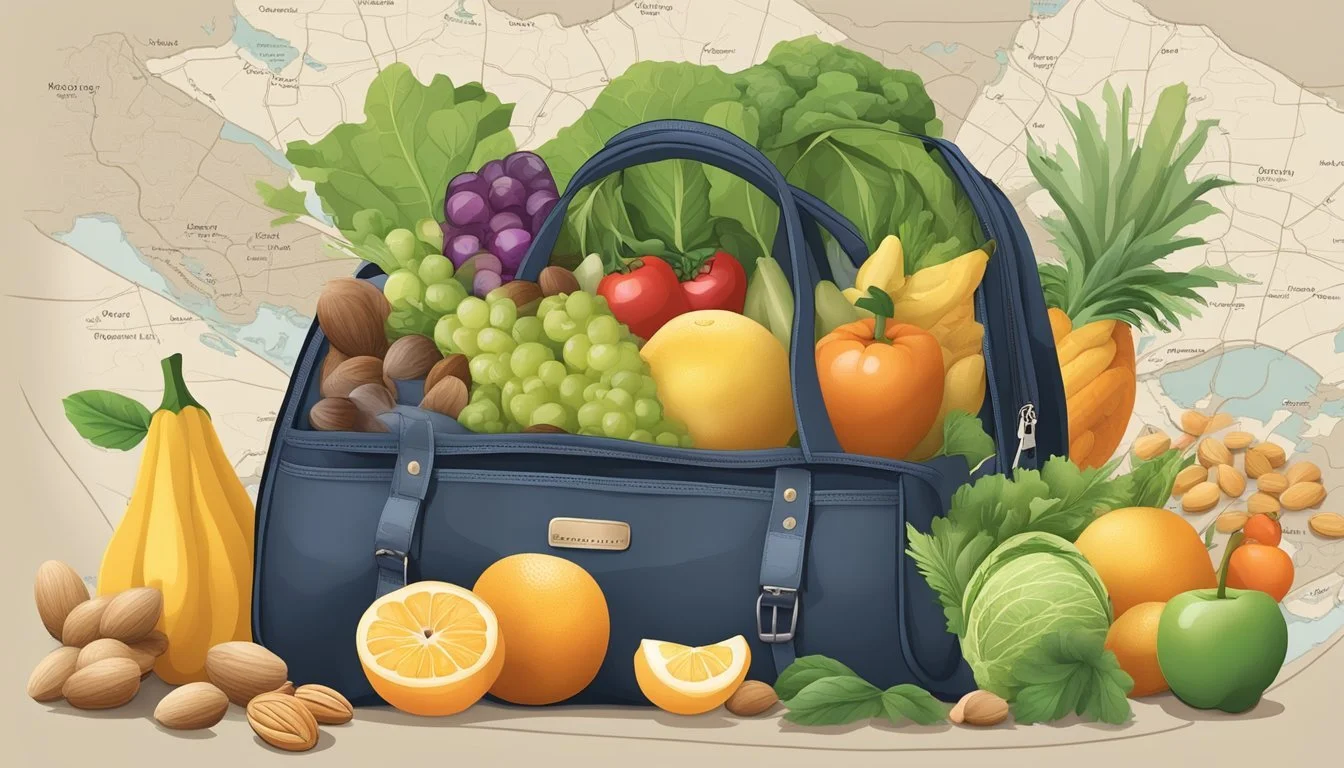Grain-Free Eating While Traveling
Navigating Meals & Snacks On-the-Go
Adopting a grain-free lifestyle can significantly affect one's health and dietary habits, especially when traveling. When on the move, maintaining this diet requires foresight and strategy, as grain-based foods are prevalent in many cultures and are often the staple offerings in travel-related situations such as airports, hotels, and restaurants. Individuals who choose to eliminate grains from their diet do so for various reasons, including allergies, sensitivities, or personal health choices, and face the particular challenge of finding appropriate food options while away from home.
Traveling poses a unique set of obstacles for grain-free eaters; the convenience of pre-packaged foods, limited availability of suitable ingredients, and the social pressure of eating what's on offer can make adherence difficult. Therefore, it is essential for those following a grain-free diet to plan ahead. This includes researching the destination's food landscape, packing suitable snacks (What wine goes well with snacks?), and learning to communicate their dietary needs effectively in different languages or contexts.
Equipped with the right strategies, travelers can navigate various dining environments, from the street markets to high-end restaurants, without compromising their grain-free principles. Being prepared allows for a more enjoyable and stress-free travel experience, ensuring that dietary needs are met no matter the location.
When traveling, maintaining a grain-free diet can be both enjoyable and health-conscious, offering a variety of options to support overall well-being. Understanding the potential impact of grain-free eating on aspects such as grain-free endurance is essential for travelers seeking to stay energized and nourished during their adventures.
Exploring the long-term pros and cons of a grain-free diet is crucial for travelers considering this dietary approach. By being mindful of the potential health benefits associated with the grain-free introduction, individuals can make informed choices that align with their well-being and dietary preferences.
Incorporating grain-free bread and grain-free granola into travel meals can offer convenient and nutritious options for individuals seeking to maintain a grain-free lifestyle while on the go. Additionally, enjoying grain-free alcoholic beverages mocktails can provide a delightful and inclusive way to savor flavorful drinks while adhering to a grain-free diet.
Considering the potential effects of a grain-free diet on grain-free fertility can provide valuable insights into the holistic impact of this dietary approach for travelers. By embracing the health benefits of grain-free eating while traveling, individuals can savor the joys of nourishing and delicious meals that support their well-being.
Understanding Grain-Free Diets
Embarking on a grain-free diet involves removing all grains from one's diet, which can be beneficial for people with certain health conditions. This lifestyle choice is often adopted to address health concerns such as celiac disease, non-celiac gluten sensitivity, and other autoimmune diseases.
Benefits of a Grain-Free Lifestyle
Health Improvements: Individuals with celiac disease or non-celiac gluten sensitivity may see a significant reduction in symptoms and inflammation when grains are eliminated from their diet.
Celiac Disease: For those diagnosed, a grain-free diet is essential as it is the only effective treatment to manage the disease and prevent further complications.
Autoimmune Diseases: Some research suggests a grain-free diet may help alleviate symptoms of various autoimmune diseases due to lowered inflammation.
Weight Management and Metabolic Health: A grain-free lifestyle might contribute to weight loss due to a lower intake of processed foods and a focus on whole foods. Additionally, it can lead to potential improvements in blood sugar levels, which is beneficial for individuals with diabetes.
Mood Regulation: Studies have indicated that dietary changes, including the adoption of a grain-free diet, may impact mood and could be a worthwhile consideration for those experiencing depression, though more research is needed in this area.
Common Misconceptions about Grain-Free Eating
Grain-Free Equals Healthy: Not all grain-free diets are created equal. The assumption that simply removing grains equates to a healthier diet is misleading. The overall quality and nutritional balance of the diet are key factors in determining its healthfulness.
Nutrient Deficiencies: There is a potential risk of nutrient deficiencies if a grain-free diet is not well planned. Whole grains are a source of valuable nutrients like fiber, B vitamins, and minerals. Therefore, individuals must ensure adequate intake of these nutrients through other food sources.
Sustainability: Some assume that a grain-free diet is difficult to maintain, especially when traveling. However, with careful planning and knowledge of suitable grain-free foods, it can be sustainable and convenient.
Complete Elimination of Carbohydrates: A grain-free diet does not mean the absence of carbohydrates. Other sources such as fruits, vegetables, legumes, nuts, seeds, and pseudocereals like quinoa and buckwheat can provide necessary carbohydrates and energy.
Planning Your Grain-Free Journey
When one embarks on a grain-free diet while traveling, it becomes crucial to research and identify suitable eating options beforehand to maintain health and dietary preferences.
Researching Restaurants and Menus
Travelers should invest time in discovering restaurants that cater to grain-free diets. With technology at their fingertips, they can utilize food apps and online reviews to find establishments with grain-free options. Restaurants that focus on whole foods usually offer selections centered on meat, fruits, and vegetables, which fit within grain-free guidelines. Additionally, calling ahead to inquire about the menu can ensure there are suitable choices available.
Identifying Grain-Free Options
Once a traveler has pinpointed restaurants, the next step is to identify what grain-free options are available. The core components of a grain-free meal typically include:
Proteins: Look for dishes featuring meat, fish, or seafood, which are inherently free from grains.
Vegetables: Opt for a variety of colorful vegetables, both raw and cooked.
Fruits: Choose fresh fruits for desserts or snacks instead of grain-based items.
Nuts and Seeds: These can be excellent snacks or toppings for salads and other dishes.
Fats: Healthy fats like olive oil or avocado can add flavor and satiety to meals.
Travelers may also consider dairy products, although some individuals on a strict grain-free regimen may exclude these. For plant-based protein options, identifying legume-based foods such as tofu or tempeh is essential, though one should verify that these do not contain grains or grain-derived additives.
Necessary Tools for Eating Grain-Free on the Go
For a seamless grain-free lifestyle while traveling, one must be equipped with the right tools that facilitate cooking and storing meals. These essentials ensure that individuals can prepare and carry their grain-free foods with ease and confidence.
Portable Kitchen Essentials
When on the move, having portable kitchen essentials is vital for someone adhering to a grain-free diet. They should consider packing compact and versatile utensils that can serve multiple functions, thus minimizing luggage space. Here's a list of indispensable portable kitchen tools:
Mini Cutting Board: Small enough to fit in any bag but sturdy enough for daily use. Useful for slicing fresh produce.
Travel Knife: A high-quality travel knife, securely sheathed, allows for quick meal preparation.
Portable Spice Kit: A small kit with essential spices to flavor meals; it could include sea salt, pepper, and herb mixes.
Foldable Utensils: A set of foldable utensils, often coming with a compact case, helps one enjoy meals anywhere.
Collapsible Bowls and Measuring Cups: Space-saving and perfect for mixing ingredients or measuring portions.
Choosing the Right Food Containers
Selecting the proper food containers is another crucial aspect of maintaining a grain-free diet while traveling. The right containers keep food fresh and prevent spillages. Here are features to look for:
Leak-Proof Seal: Containers should have an airtight seal to ensure no spillages occur during transport.
BPA-Free Materials: Look for containers made from BPA-free plastics or opt for glass or stainless steel for health and sustainability.
Microwave and Dishwasher Safe: For convenience, choose containers that can be easily reheated and cleaned.
Compartmentalized Design: Some containers come with compartments which are ideal for separating different meal components, keeping flavors intact.
By equipping themselves with these travel-friendly kitchen tools and containers, individuals can maintain their grain-free eating habits without hassle or interruption.
Packaging Your Own Grain-Free Meals and Snacks
When traveling, individuals adhering to a grain-free diet can maintain their eating habits by preparing and packing their own meals and snacks. Thoughtful selection of ingredients ensures meals are nutrient-dense, satisfying, and compliant with a grain-free or paleo lifestyle.
Homemade Meal Ideas
For travelers on a grain-free diet, the main challenge lies in finding suitable meal options that provide a balance of proteins, vegetables, and healthy fats. They can assemble meals ahead of time with components like hard-boiled eggs, grilled chicken, or flaked fish, all high in protein. Pairing these proteins with a mix of fresh vegetables such as bell peppers, cucumbers, and leafy greens will ensure a well-rounded and filling meal.
A sample meal plan could include:
Breakfast: Scrambled eggs with spinach and avocado
Lunch: Grilled chicken salad with a variety of colorful vegetables and olive oil dressing
Dinner: Baked salmon with a side of roasted Brussels sprouts and butternut squash
Snacks for Sustained Energy
Snacks are crucial for maintaining energy levels during travel and should be both convenient and healthy. Options rich in good fats and proteins can provide sustained energy and stave off hunger. Some excellent grain-free snack choices include nuts such as almonds or walnuts, seeds like pumpkin or sunflower, and dairy-based snacks including cheese cubes or Greek yogurt. For convenience, travelers can also prepare homemade trail mix or protein balls using nut butters and coconut flakes.
Portable snack ideas:
Nuts: Almonds, pecans, macadamia nuts
Seeds: Sunflower seeds, pumpkin seeds
Dairy: Cheese sticks, plain Greek yogurt (with added berries or nuts)
Selecting Suitable Accommodation
When traveling on a grain-free diet, one's lodging choice can greatly impact their ability to maintain dietary restrictions. Here are considerations to make when selecting accommodations to stay on track with grain-free eating.
Accommodation with Suitable Cooking Facilities
Choosing accommodations with well-equipped kitchens is critical for travelers following a grain-free diet. These travelers should look for listings that offer a kitchenette or full kitchen, which includes:
Stovetop or hot plate: essential for cooking meals from scratch.
Refrigerator: to store fresh produce and perishables.
Microwave: for quick reheating.
Cookware and utensils: necessary for meal preparation without cross-contamination from grains.
Travelers can filter for such amenities when booking through hotel websites or vacation rental platforms, ensuring they have the necessary equipment to prepare their own grain-free meals.
Farm to Table Hotels
For those seeking both comfort and assurance in grain-free options, farm to table hotels are an excellent option. These accommodations typically offer:
Fresh, local produce: emphasizing fruits and vegetables that suit grain-free diets.
Transparent meal preparation: kitchens that are often open to customizing dishes for grain-free requirements.
These hotels align closely with the grain-free philosophy, sourcing ingredients from nearby farms, which provides guests not only with fresh options but also the peace of mind that their food adheres to their dietary constraints.
Sticking to Grain-Free While Dining Out
Dining out while adhering to a grain-free diet, such as paleo or gluten-free, requires preparation and clarity. Being informed and communicative are essential for a successful dining experience.
Communicating Dietary Restrictions
When they dine out, individuals on grain-free diets should inform the server of their dietary restrictions promptly. It is not only a matter of preference but a health necessity for some. Alleviating the risk of cross-contamination is essential, particularly for those with celiac disease or gluten sensitivity. A smart strategy is to highlight the seriousness of their dietary needs and to ask questions about menu items, including if a dish is cooked with any grain-based ingredients or shares equipment with grain-containing foods.
Mention Cross-Contamination: For those with celiac or severe gluten intolerance, ensure that the staff is aware of the necessity to prevent cross-contamination.
Ask for Recommendations: Often, staff are knowledgeable about the menu and can suggest modifications to dishes that make them grain-free.
Be Specific: Instead of simply stating "grain-free," clarify that wheat, barley, rye, and non-gluten-free oats must be avoided.
Deciphering Menus
Navigating menus can be daunting, but there are usually viable options. They should look for keywords that typically indicate grain-free foods, such as "gluten-free," "paleo-friendly," or "bunless." Many restaurants now cater to a variety of dietary needs, offering specific sections or items that are safe for those on restricted diets. Ingredients are often listed on the menu, but if not, they should not hesitate to inquire about the details of a dish.
Salads: Often a safe bet, but they should ensure dressings and toppings are grain-free.
Grilled Proteins: Foods such as steak, chicken, or fish are typically grain-free; however, they must check for marinades or seasonings that could contain grains.
Vegetable Sides: Steamed, roasted, or grilled vegetables (What wine goes well with grilled vegetables?) without any added sauces or breading can be great grain-free choices.
By being proactive about communication and menu knowledge, individuals can enjoy healthy, grain-free meals even while dining at restaurants.
Grain-Free Substitutes for Common Foods
When adhering to a grain-free diet, one encounters the challenge of finding suitable substitutes for common grain-based foods. The focus is on identifying alternatives that are free from grains such as wheat, rye, barley, and oats, which are common sources of gluten.
Replacements for Breakfast Cereals
Traditional breakfast cereals often contain gluten and grains such as wheat, rye, and barley. Individuals looking for grain-free options can turn to breakfast alternatives that are satisfying and easy to make.
For oatmeal or cream of wheat: A hot, comforting bowl can be created using ground flaxseeds or chia seeds. When mixed with hot water or a dairy-free milk alternative, these seeds swell and take on a porridge-like consistency. Flaxseeds and chia seeds are rich in omega-3 fatty acids and fiber, which makes them a hearty and healthy way to start the day.
For cold breakfast cereals: One can try making a grain-free muesli or granola using nuts and seeds such as almonds, sunflower seeds, and coconut flakes. Toast these ingredients lightly in the oven with a touch of cinnamon and sweetener, if desired, for a tasty and crunchy alternative to traditional muesli.
Alternatives to Wheat-Based Breads
Grain-free diets require steering clear of wheat-based breads, including favorites like bagels (how long do bagels last?) and pizza crusts. Fortunately, there are grain-free flours that can be used for baking.
For breads and bagels: Almond flour and coconut flour are popular grain-free options that can create bread-like textures. Almond flour has a nutty taste and is dense, which is ideal for making grain-free breads, while coconut flour is lighter and can be used to make softer bread products.
For pizza crust: There are creative alternates that bypass traditional grains. A mixture of cauliflower rice, egg, and cheese can form a dough-like consistency perfect for a pizza base. This base can then be baked until it's golden and crispy. Another choice is to use a blend of almond flour and eggs, pressed and shaped into a thin crust, providing a satisfying crunch without the grains.
By incorporating these substitutes into their meals, individuals on a grain-free diet can still enjoy variations of their favorite dishes while traveling or at home.
Navigating Foreign Cuisine
When traveling, individuals adhering to grain-free diets face unique challenges. Being knowledgeable about international grain-free options and cultural food practices can help maintain health and enjoy a diverse range of cuisines.
International Grain-Free Options
Many international cuisines offer grain-free dishes that focus on protein and vegetables. Here's a brief guide to help identify appropriate foods:
Asian Cuisine: Options such as Thai curries that use coconut milk, Vietnamese pho without noodles, and Japanese sashimi are naturally grain-free.
European Cuisine: Mediterranean diets are rich in olive oil, fish, and leafy greens. Look for Spanish tapas like gambas al ajillo (garlic shrimp) or Greek salads.
Middle Eastern Cuisine: Kebabs made with lamb or chicken, grilled vegetables, and salads like fattoush (without bread) can be grain-free.
South American Cuisine: Cuisines here often feature meat and vegetables, like Brazilian churrasco (grill), which is an array of flame-grilled meats served without any grain sides.
When at restaurants, one should not hesitate to ask the staff about the ingredients in dishes to avoid unintentional grain consumption.
Cultural Considerations
Cultural sensitivity is crucial when dining in foreign countries. It is polite to learn a few phrases to inquire about food content without offending the hosts. For example:
"Does this contain any grains?" or
"I follow a special diet, can you suggest a grain-free option?"
Many cultures take pride in their hospitality and are often willing to accommodate dietary requests. However, some traditional dishes might inherently contain grains, so understanding and flexibility are essential.
Grain-free travelers should research traditional dishes of their destination ahead of time. And for those with severe gluten sensitivity or celiac disease, extra caution is needed since cross-contamination is a possibility even if the dish is inherently grain-free.
Avoiding Hidden Grains and Gluten
When traveling, individuals adhering to a grain-free and gluten-free diet need to be vigilant to avoid hidden sources of grains and gluten. It's essential to recognize that gluten is a protein found not only in wheat, but also in barley, rye, and varieties such as spelt and triticale. Oats, though naturally gluten-free, may be cross-contaminated if processed in facilities that also handle wheat.
Restaurants: Dining out requires careful communication. Patrons should inform servers about their dietary restrictions and verify whether dishes do not contain gluten or grains. They should inquire if there's a risk of cross-contamination as many kitchens use the same surfaces or fryers for gluten-containing and gluten-free foods.
Soy Sauce & Processed Foods: Soy sauce often contains wheat and must be avoided unless it is specifically labeled as gluten-free. Similarly, processed foods can be deceptive; they may include malt derived from barley or modified food starch made from wheat.
Often Gluten-Containing Foods Gluten-Free Alternates Soy Sauce Tamari (labeled gluten-free) Regular Pasta Gluten-free pasta Bread and Pastries Gluten-free options
Travel Tips:
Pack Snacks: Bring gluten-free snacks to avoid being caught out.
Research: Look up gluten-free restaurants and stores ahead of time.
Kitchenette: Opt for accommodations with a kitchenette to prepare safe meals.
Stay clear of buffets where the risk of cross-contact is high, and consider carrying cards that explain one's dietary needs in the local language. By staying informed and cautious, those avoiding grains and gluten can enjoy safe and satisfying travels.
Supplementing Your Diet on the Road
Maintaining a grain-free diet while traveling calls for a keen awareness of nutritional balance. This section focuses on ensuring that travelers monitor vital nutrient intake and select travel-friendly supplements to remain nourished and energized on the go.
Vital Nutrients to Monitor
When adhering to a grain-free diet, it's crucial to monitor key nutrients that grains typically provide. Nutrient-dense foods are paramount, and individuals often need to pay closer attention to vitamins and minerals that may be lacking.
Vitamins: Ensure adequate intake of B vitamins, especially B1 (thiamine), B3 (niacin), and folic acid, which are commonly found in grains.
Minerals: Magnesium, iron, and fiber are essential minerals often derived from grains that must be sourced from other foods or supplements.
Choosing gluten-free and dairy-free options can supplement the diet without introducing unwanted elements. Foods such as leafy greens, nuts, seeds, and lean proteins should be prioritized to maintain a balanced intake of these critical vitamins and minerals.
Travel-Friendly Supplements
Travelers can sustain their grain-free regimen by packing carefully selected supplements that align with their dietary needs. Convenience and portability are key.
Daily Multivitamin: Opt for a comprehensive multivitamin tailored for grain-free lifestyles to support overall health with essential nutrients.
Mineral Supplements: Individual minerals like magnesium or iron can be taken according to personal dietary gaps. Always consider professional medical advice before starting a supplement regime.
Protein Powders: Plant-based, gluten-free protein powders offer a quick and easy protein boost, ideal for making shakes when options are limited.
Packaging options such as individual sachets or small containers help manage supplement intake and ensure consistency in nutrition while traveling. Always read labels to ensure that supplements adhere to a grain-free, gluten-free, and dairy-free diet, thereby preventing inadvertent consumption of unwanted substances.
Impact of Grain-Free Eating on Social and Business Travel
Adopting a grain-free lifestyle, such as the Paleo diet, necessitates careful planning, especially when traveling for business or pleasure. Individuals on a grain-free diet might face challenges when dining in restaurants, as grain-based foods are a staple in many cuisines. This could limit menu options, prompting the need for travelers to communicate dietary restrictions clearly to the kitchen staff—a practice that becomes crucial to remain compliant with their diet.
Business Travelers often attend working lunches or dinners where they have little control over the food served. They can mitigate this by:
Suggesting restaurants that cater to grain-free options
Pre-ordering meals that fit their dietary needs
For social travelers, the diet may also impact group dynamics as communal dining is a social affair. They can:
Educate travel companions about their dietary needs
Identify places that offer flexibility or have a varied menu
Those staying in accommodations with a kitchenette have the advantage. They can prepare their meals, ensuring compliance with their grain-free diet. Here’s how they can maintain this while traveling:
Shopping: Prioritize fresh produce and grain-free substitutes
Cooking: Use simple recipes that require minimal ingredients
A grain-free diet doesn't have to be isolating or excessively difficult when traveling. There are strategies to manage and maintain this lifestyle while on the road:
Strategy Description Meal Prep Preparing snacks and meals in advance can save time and reduce reliance on restaurants. Pack Essentials Travel with a supply of grain-free staples like nuts and seeds. Restaurant Research Look for grain-free friendly restaurants or those that are accommodating to dietary requests. Clear Communication When dining out, succinctly express dietary preferences to avoid confusion.
Travelers may still enjoy a variety of nourishing meals and engage in social activities while adhering to their dietary regimen. Careful preparation and open communication go a long way in making grain-free traveling a seamless experience.
Key Takeaways for Traveling Without Grains
When one embarks on a journey with a grain-free lifestyle, planning is essential. Before setting out, travelers should research their destination for local stores and restaurants that cater to grain-free and gluten-free diets.
Preparation: They should stock up on healthy, grain-free snacks such as nuts and seeds – like pistachios – which are both satisfying and nutritious. Raw vegetables like carrot sticks, celery, cucumbers, and snap peas are easy to pack and provide a crunchy, hydrating snack without the grains.
Hydration: Maintaining proper hydration is critical. Travelers should carry a reusable water bottle to ensure they have access to water, helping them stay full and energized. Adequate hydration also aids digestion, an important consideration when adjusting to new foods while traveling.
Eating Out: When dining at restaurants, individuals should opt for meals rich in lean proteins and fibers. They could focus on dishes featuring proteins like chicken or fish, paired with a variety of vegetables, to maintain a balanced diet without grains.
Snack Wisely: Opting for gluten-free, grain-free bars or bringing along homemade snacks can help travelers resist the temptation of less healthy, grain-centric options often found at transportation hubs and tourist attractions.
By following these steps, travelers can enjoy their adventures without deviating from their grain-free lifestyle. The key is to stay informed, choose wisely, and come prepared.
Tips for Grain-Free Traveling Why it's Helpful Research and prepare snacks Ensures access to grain-free options Carry a water bottle Promotes fullness and hydration Focus on protein and fiber Sustains energy and satisfaction Be picky with snacks Prevents reliance on grain-heavy alternatives











